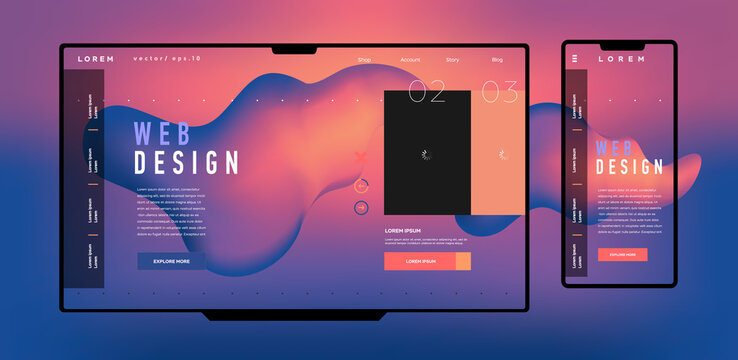An In-depth Overview of the most effective Practices in Internet Style for Creating User-friendly and Accessible Online Platforms
The efficiency of an online system pivots substantially on its design, which must not just draw in customers yet likewise lead them flawlessly via their experience. Understanding these concepts is vital for developers and developers alike, as they straight impact customer fulfillment and retention.
Understanding Individual Experience
Understanding individual experience (UX) is crucial in website design, as it directly affects just how visitors communicate with a website. A properly designed UX ensures that individuals can navigate a site without effort, access the details they seek, and full wanted actions, such as signing or making a purchase up for a newsletter.
Secret elements of efficient UX design include use, ease of access, and aesthetic appeals. Use focuses on the simplicity with which individuals can achieve jobs on the website. This can be attained with clear navigating structures, logical content organization, and responsive comments systems. Availability guarantees that all individuals, including those with impairments, can connect with the site efficiently. This includes adhering to established guidelines, such as the Web Material Ease Of Access Guidelines (WCAG)
Looks play a critical role in UX, as visually appealing layouts can improve individual contentment and involvement. Shade plans, typography, and images must be attentively chosen to develop a cohesive brand name identification while also promoting readability and understanding.
Inevitably, prioritizing individual experience in internet layout cultivates greater customer complete satisfaction, urges repeat sees, and can dramatically improve conversion prices, making it an essential aspect of effective digital approaches. (web design)
Value of Responsive Style
Receptive design is a crucial element of modern-day internet development, making certain that sites give an optimal viewing experience throughout a variety of devices, from desktop computers to smartphones. As individual habits progressively shifts towards mobile browsing, the requirement for web sites to adjust flawlessly to various screen sizes has actually become critical. This versatility not just boosts usability however likewise significantly effects individual involvement and retention.
A responsive design employs fluid grids, adaptable images, and media queries, permitting a cohesive experience that maintains performance and aesthetic stability no matter device. This approach eliminates the need for customers to zoom in or scroll horizontally, bring about an extra intuitive communication with the material.
In addition, online search engine, significantly Google, prioritize mobile-friendly sites in their rankings, making responsive layout important for maintaining exposure and access. By taking on receptive design principles, businesses can get to a more comprehensive audience and enhance conversion rates, as customers are more probable to involve with a site that provides a consistent and smooth experience. Inevitably, responsive layout is not just a visual option; it is a tactical necessity that mirrors a dedication to user-centered style in today's digital landscape.
Simplifying Navigating Structures
A well-structured navigation system is important for boosting the individual experience on any type of internet site. Streamlining navigation structures not only aids individuals in finding information swiftly yet likewise cultivates involvement and minimizes bounce rates. To accomplish this, internet developers must prioritize quality through using uncomplicated labels and groups that reflect the content properly.

Integrating a search attribute better enhances functionality, permitting individuals to locate material directly. In addition, applying breadcrumb trails can supply users with context concerning their place within the site, promoting simplicity of navigation.
Mobile optimization is another crucial aspect; navigating ought to be touch-friendly, with clearly defined buttons and links to suit smaller screens. By reducing the variety of clicks needed to accessibility material and making certain that navigating is constant throughout all web pages, designers can develop a seamless customer experience that motivates expedition and decreases stress.
Prioritizing Availability Standards
Roughly 15% of the international population experiences some form of handicap, making it important for internet developers to focus on accessibility requirements in their jobs. Access incorporates different elements, consisting of visual, auditory, cognitive, and electric motor impairments. By adhering to established standards, such as the Internet Content Ease Of Access Guidelines (WCAG), developers can create inclusive digital experiences that provide to all individuals.
One fundamental practice is to make certain that all content is perceivable. This consists of offering alternate message for images and making certain that video clips have transcripts or inscriptions. Key-board navigability is vital, as several users depend on key-board shortcuts rather than computer mouse interactions.
 In addition, shade comparison need to be meticulously taken into consideration to fit individuals with visual impairments, making sure that text is clear against its history. When creating types, tags and error messages must be clear and descriptive a knockout post to assist individuals in completing jobs effectively.
In addition, shade comparison need to be meticulously taken into consideration to fit individuals with visual impairments, making sure that text is clear against its history. When creating types, tags and error messages must be clear and descriptive a knockout post to assist individuals in completing jobs effectively.Lastly, performing use testing with individuals who have disabilities can give indispensable insights - web design. By prioritizing access, internet designers not just abide with legal standards yet also increase their target market why not try these out reach, cultivating a more comprehensive on the internet environment. This dedication to ease of access is vital for a truly accessible and user-friendly internet experience
Utilizing Aesthetic Power Structure
Clarity in design is extremely important, and using visual power structure plays a critical function in achieving it. Aesthetic pecking order describes the arrangement and presentation of elements in such a way that plainly indicates their value and guides individual focus. By tactically using dimension, color, spacing, and comparison, developers can create a natural circulation that directs individuals via the material perfectly.
Utilizing bigger fonts for headings and smaller ones for body message develops a clear difference in between sections. Additionally, employing contrasting backgrounds or strong colors can attract focus to essential information, such as call-to-action buttons. White room is just as important; it assists to avoid clutter and enables individuals to concentrate on one of the most essential aspects, boosting readability and total user experience.
One more secret element of aesthetic pecking order is the use of images. Relevant images can enhance understanding and retention of info while additionally separating text to make content more absorbable. Inevitably, a well-executed aesthetic hierarchy not just boosts navigating but likewise promotes an user-friendly interaction with the site, making it more most likely for individuals to accomplish their purposes successfully.
Conclusion

Additionally, the efficient usage of aesthetic pecking order enhances user engagement and readability. By focusing on these components, internet developers can substantially enhance individual experience, making certain that on the internet platforms meet the varied needs of all users while assisting in efficient interaction and contentment.
The effectiveness of an online system hinges considerably on its design, which should not only attract users yet also lead them flawlessly with their experience. By adopting receptive design concepts, services can reach a wider target market and enhance conversion prices, as individuals are extra most likely to engage with a site that offers a consistent and smooth experience. By sticking to established guidelines, such as the Internet Content Ease Of Access Guidelines (WCAG), developers can develop inclusive digital experiences that provide to all users.
White area is equally important; it helps to prevent mess and allows individuals to focus on the most vital elements, improving readability and total user about his experience.
By focusing on these elements, web developers can significantly enhance customer experience, guaranteeing that on-line platforms meet the varied needs of all individuals while assisting in reliable interaction and satisfaction.